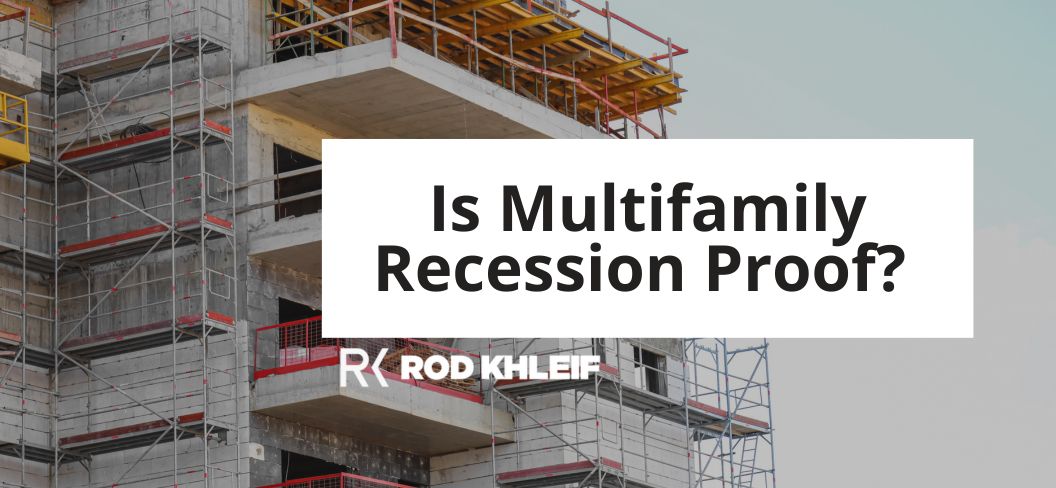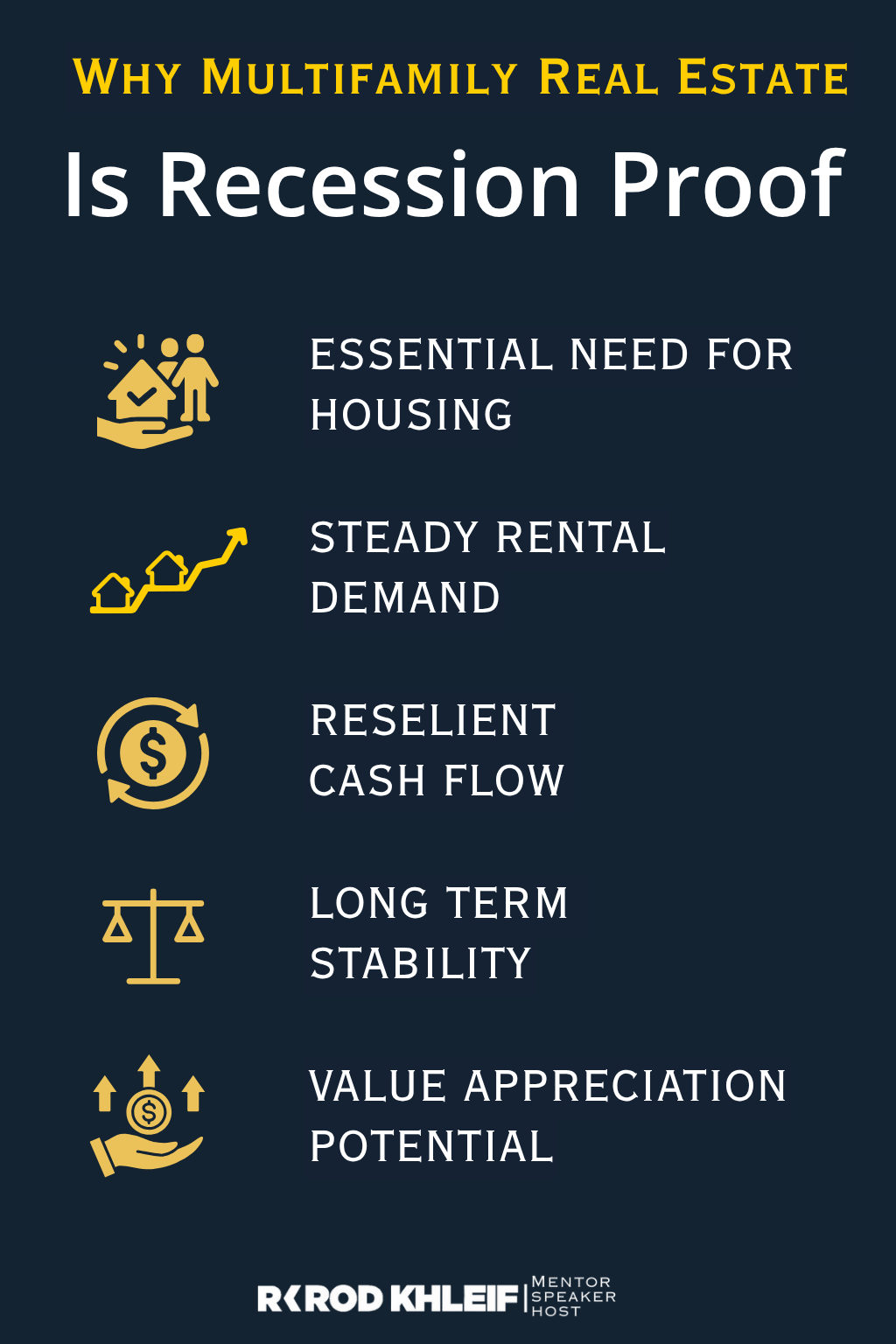Is Multifamily Real Estate Recession Proof? Exploring Its Stability in 2025
With rising interest rates, inflation concerns, and economic uncertainty looming over the real estate market in 2025, one question has gained renewed attention: Is multifamily recession proof? While no investment is completely immune to market downturns, multifamily real estate continues to prove itself as one of the most resilient and recession resistant asset classes available today.
In this article, we’ll explore why multifamily real estate performs well during economic downturns, compare it to other asset types, and answer popular questions about investing in multifamily properties during a recession.
Why Multifamily Real Estate Is More Recession Resistant Than Other Investments
Unlike single family homes, commercial office space, or retail properties, multifamily housing meets a basic human need: shelter. Regardless of economic conditions, people still need a place to live. During a recession, homeownership often declines, increasing the demand for rentals. This is especially true for affordable and workforce housing.
Here are several reasons why multifamily investing holds up well in recessions:
1. Consistent Demand for Housing
Even during economic downturns, people prioritize rent payments. If anything, demand for rental units tends to rise when homeownership becomes less attainable due to high interest rates, job loss, or stricter lending requirements.
2. Diversified Income Streams
Multifamily properties typically have multiple tenants, which spreads out the risk. Losing one tenant doesn’t result in 100% vacancy, unlike a single family home or small commercial space.
3. Cash Flow and Cap Rate Stability
Properly managed multifamily assets generate steady cash flow and tend to retain stronger cap rates even in a down market. Investors can maintain profitability while waiting out the downturn.
4. Government Support Programs
In times of economic stress, renters and landlords often benefit from government aid such as rent subsidies, tax incentives, and emergency assistance. These measures help maintain occupancy and rental income.
5. Increased Flexibility with Lease Terms
Multifamily leases are typically shorter (6-12 months), allowing landlords to adjust rent rates faster than office or retail leases, which may be locked in for 3-10 years. This flexibility is crucial in responding to market conditions.
FAQs: Multifamily Real Estate and Recession Risk
Let’s address some of the most common questions people ask in 2025:
Is multifamily real estate safe in a recession?
While no investment is completely safe, multifamily real estate is considered one of the most recession resistant options. The combination of rental demand, stable cash flow, and risk diversification makes it safer than many other sectors.
Do rents go down during a recession?
In some luxury markets, rents may decrease. However, in Class B and C housing (workforce and affordable housing), demand often increases during a recession as people downsize or delay buying homes.
Is now a good time to invest in multifamily real estate (2025)?
Yes. While the economy may be shifting, 2025 presents opportunities to buy distressed or undervalued properties, especially from over leveraged owners. Locking in assets with strong fundamentals can position you for long-term success.
How does multifamily compare to commercial real estate in a recession?
Commercial real estate, particularly office and retail, is more volatile in downturns. Businesses close, tenants default, and vacancies rise. Multifamily assets, by contrast, typically maintain higher occupancy and require less leasing effort.
Can you get financing for multifamily properties in a recession?
Lenders are generally more cautious during recessions, but multifamily is still viewed as a low risk asset. Government backed loans (like Fannie Mae and Freddie Mac) remain available for well qualified buyers.
Download our FREE Financing Your Multifamily Purchase Guide to learn more.
What Types of Multifamily Properties Perform Best in Recessions?
Not all multifamily assets are created equal. The ones most likely to outperform during a recession include:
Class B and C Workforce Housing
These properties serve working-class tenants who need affordable living options. During recessions, tenants from Class A (luxury) buildings often downsize into Class B/C housing, increasing demand.
Properties in Growing Secondary Markets
Cities with steady job markets, diverse economies, and population growth (e.g., Charlotte, Tampa, Phoenix) see stronger performance even in downturns. Investors should focus on location fundamentals.
Smaller Apartment Buildings (5-50 units)
These assets are more agile and often less exposed to institutional competition. They’re ideal for newer investors looking to build recession-resistant portfolios.
Value Add Properties
Recessions provide opportunities to buy underperforming assets at a discount. Investors can renovate, reposition, and raise rents post-recovery, resulting in strong equity growth.
Strategies to Recession Proof Your Multifamily Portfolio
To thrive during uncertain times, multifamily investors should implement strategic risk-management tactics:
1. Stress Test Your Deals
Underwrite conservatively. Assume lower rent growth, higher vacancy, and increased operating expenses. If the deal still cash flows under stress conditions, it’s worth pursuing.
2. Maintain Healthy Reserves
Set aside 6-12 months of operating capital per property. This helps cover unexpected repairs, shortfalls, or tenant turnover.
3. Focus on Tenant Retention
Happy tenants are more likely to renew leases. Improve communication, offer renewal incentives, and respond promptly to maintenance requests.
4. Improve Operational Efficiency
Adopt technology like property management software, online payments, and digital leasing tools to streamline operations and reduce costs.
5. Stay Educated and Connected
Join investor groups, attend webinars, and learn from mentors like Rod Khleif. The more informed you are, the better your decisions during tough times.
Want to learn more about how to recession proof your multifamily asset? Check out this article here.
Multifamily vs. Other Real Estate in a Recession: A Quick Comparison
| Asset Class | Recession Resilience | Vacancy Risk | Cash Flow Stability | Demand Source |
|---|---|---|---|---|
| Multifamily | High | Moderate | High | Constant (housing) |
| Office | Low | High | Low | Business-based |
| Retail | Low | High | Low | Consumer spending |
| Industrial | Moderate | Low | Moderate | Logistics/manufacturing |
| Single-Family Rental | Moderate | High | Moderate | Individual tenants |
Final Verdict: Is Multifamily Recession Proof in 2025?
While no investment is entirely recession-proof, multifamily real estate is about as close as it gets. It offers diversified income, strong rental demand, and adaptability that make it far more stable than other asset types in tough economic times.
Whether you’re buying your first 4-unit or managing a 300-door portfolio, now is the time to lean into the strategies that make multifamily thrive, even when the economy doesn’t.
Interested in building your recession proof multifamily portfolio? Explore Rod Khleif’s coaching program or download the free book How to Create Lifetime Cash Flow Through Multifamily Properties today.

Stay focused, stay prepared, and remember fortune favors the bold, especially in real estate.



